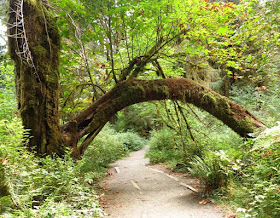As previously noted, Olympic National Park is a
triple treat. It consists of three very different ecosystems—rain forest,
mountains, and beaches. After visiting the first two areas, it was time to head
to the coast. Rialto Beach, 30 minutes west of Forks, Washington, was our next
destination.
Rialto is a dramatic, windswept beach famous for
enormous driftwood, tide pools teeming with marine life like starfish,
anemones, shellfish, and crabs. Giant boulders, some with trees growing on top,
rise out of the water to create a haunting image.
The air is filled with the constant roar of an ocean
in motion, tossing waves as high as 30 feet onshore. When walking near the
water you must be careful as the tide surges at the most inopportune times,
making wet shoes a real possibility.
The weather was cool, misty, and windy, so we zipped up our jackets and trampled over fallen logs, seaweed that had washed ashore, and puddles of ocean water. A few gulls and ducks speckled the water’s edge, and we even caught a glimpse of a beaver.
Photos by Larry and Beverly Burmeier
Instead of smooth sand, the beach is a conglomerate
of rocks, pebbles, and driftwood. But, even in this messy state, there’s a
distinct beauty unique to northern coastal landscapes.
Keeping an image of that tricky terrain in mind, you
might wonder why we chose to hike a mile and a half along the beach to
Hole-in-the-Wall. Simply put, we were intrigued by the giant outcropping in the
water into which a large arch has been worn by wind and water. The weather was cool, misty, and windy, so we zipped up our jackets and trampled over fallen logs, seaweed that had washed ashore, and puddles of ocean water. A few gulls and ducks speckled the water’s edge, and we even caught a glimpse of a beaver.
Once we got near the arch, our friend Deb and I
wanted to get to the other side of the enormous boulder. That required climbing
a series of steep dirt steps to the top of the rock formation, then going down
from the ridge to the other side, something that’s only possible during low
tide. But it was a wonderful view and a great spot for photos.
Leaving Rialto Beach, we drove back to U.S. 101, the
road that has encircled a huge expanse of Olympic National Park since 1930s. After
turning onto Upper Hoh River Road, which runs parallel to the Hoh River beneath
a lush canopy of spruce, western hemlock, big leaf maple, and Douglas fir
trees, we drove another 19 miles to the Hoh Visitor Center.
There we followed the Hall of Mosses Trail, a loop through
unimaginable greenness that takes about 45 minutes to complete. A bright sun
shone on a pool of water filled with shimmering water plants, gleaming like
emerald jewels in a sea of overhanging moss. These patches of brilliance contrasted
with the dark canopy of trees growing up to 200 feet tall while seeking the
sun.
Spider-like branches dripped with long, feathery
mosses that brought to mind a Halloween fright house. The trail was a verdant
mass of fuzzy and furry ground plants and leaves ranging from barely there to
sprawling maple leaves. This rain forest was truly an ecological delight.
Photos by Larry and Beverly Burmeier









No comments:
Post a Comment